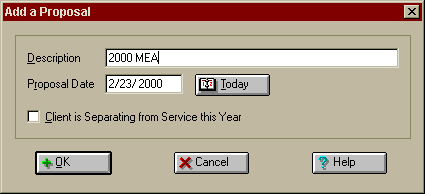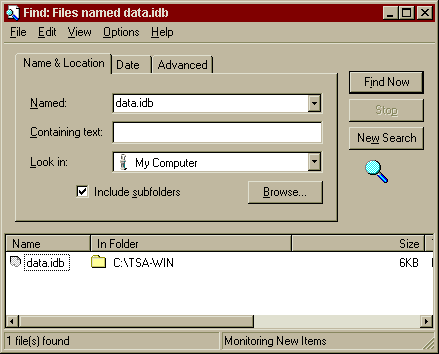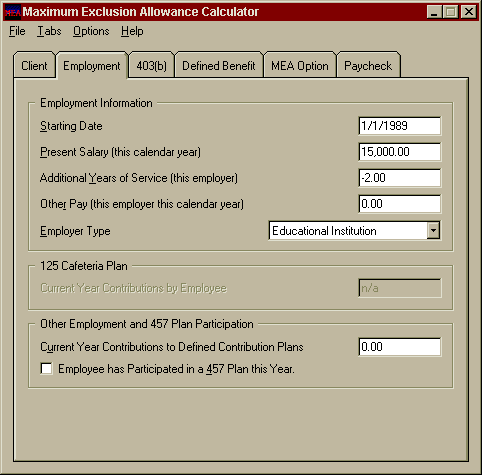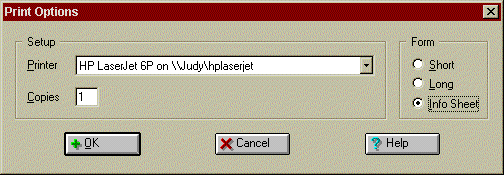
MEA Frequently Asked Questions

| Question: |
My customer is depositing $400 per month into her 403(b) plan. As of June 30th she has paid in $2400 into her 403(b). Which field do I enter this amount? |
| Answer: |
You donít. Current year contributions for the 403(b) have already been taken into account in the formula. Remember to press the F1 Help key if you have questions about any particular field in the software. |
| Question: |
My customer doesnít plan to retire at age 60 as stated in your software on the Defined Benefit Tab. He plans to retire at age 65 so he can get the increased pension benefits offered by the State of California. How do I change this? |
| Answer: |
You donít, nor should you try. The primary misunderstanding in this area arises from the belief that the MEA is based on the pension income that the customer will actually have in the future. This is not the case. The Maximum Exclusion Allowance is based on the "normal" plan benefit for the particular pension plan your customer is participating in. A good example is a teacher in California who wants to take advantage of the increase in STRS (State Teacher's Retirement System) benefits if he/she works until age 65. However, for STRS, "the normal retirement age" -- as stated in the plan document -- is generally age 60. The "normal" pension benefit is 2% of salary times the number of years worked. The MEA Software includes these tables and makes these calculations for you. |
| Question: | I have a teacher who just moved to San Diego, California from Riverside. She worked for 25 years in Riverside and is age 55 today. She plans to work 10 more years. Assuming her current $50,000 salary, she should receive 35 years X 2.5% X $50,000 or $43,750 at retirement. On the Defined Benefit tab it shows only $5,000. Why is there such a difference? |
| Answer: |
For MEA purposes, retirement benefits are calculated from the date of employment from their current employer and using the normal retirement age based on the plan document. The fact that your teacher has 25 years of service with STRS is irrelevant. The fact that she plans to work to age 65 is also irrelevant (see the above question). Since age 60 is the "normal" retirement age for this teacher, based on 5 years service with this employer (school district), the retirement income for MEA purposes is 5 years X 2% X $50,000 or $5,000. |
| Question: | When I bring up an existing file from 1999, the printout still says 1999 and the preparation date does not change. I can't seem to find where to change the date to 2000. I don't want to have to re-create all my proposals. Help! |
| Answer: |
The MEA Calculation is based on the Proposal Date field which appears when you press the "Edit" button on the Client Tab.† The software is designed to work this way so you can recreate a 1999(or any previous year) MEA in the future. This same window has a "Description" field.† We recommend that you title each MEA that you run "1999 MEA," "2000 MEA," etc.† so that you can tell them apart from one another in the future. To create a 2000 MEA from the data that you saved 1999, simply press the "Add" button on the Client Screen. Change the Description to "2000 MEA," then press the "Today" button to reset the Proposal Date field to Today's Date.† All the information from 1999 MEA will transfer to the input fields. Make changes for 2000 as necessary. 
|
| Question: | How do I backup my saved MEA illustrations? |
| Answer: |
Your data files are stored in the file Data.idb. Unless you have more than 1500 saved illustrations, this file should be small enough to fit on a floppy disk. Here's the easiest way to find and back up this file on a floppy disk: |
| Question: |
How do you calculate an MEA for Part-Time Employees? |
| Answer: |
Unfortunately, MEA is not designed to calculate the Maximum Exclusion Allowance for part time employees. To do this properly requires a host of input questions to determine what percentage of full time the employee is. The work around for this design limitation is to calculate the percentage of full time
yourself. For example: Assume a library worker has worked an average of 32 hours per week
ten years. Full time employment for this school district is considered to be 40 hours per
week. 32 divided by 40 = 80%. Since this person has worked for ten years, but only 80% of
the time, put -2 in the "Additional Years of Service"
field (see below).
Do the math: 10 years times 80% = 2 years. |
| Question: |
It would be advantageous to be able to print out a blank questionnaire for clients to fill out and mail back to us. Can you add this to the software? |
| Answer: |
This feature is already there. One of the Print Options (see the screen below) is to print the
blank questionnaire that you want. Furthermore, it prints your name, address, and phone
number at the bottom of each page. Be sure to change the
number of copies that you want printed. |


